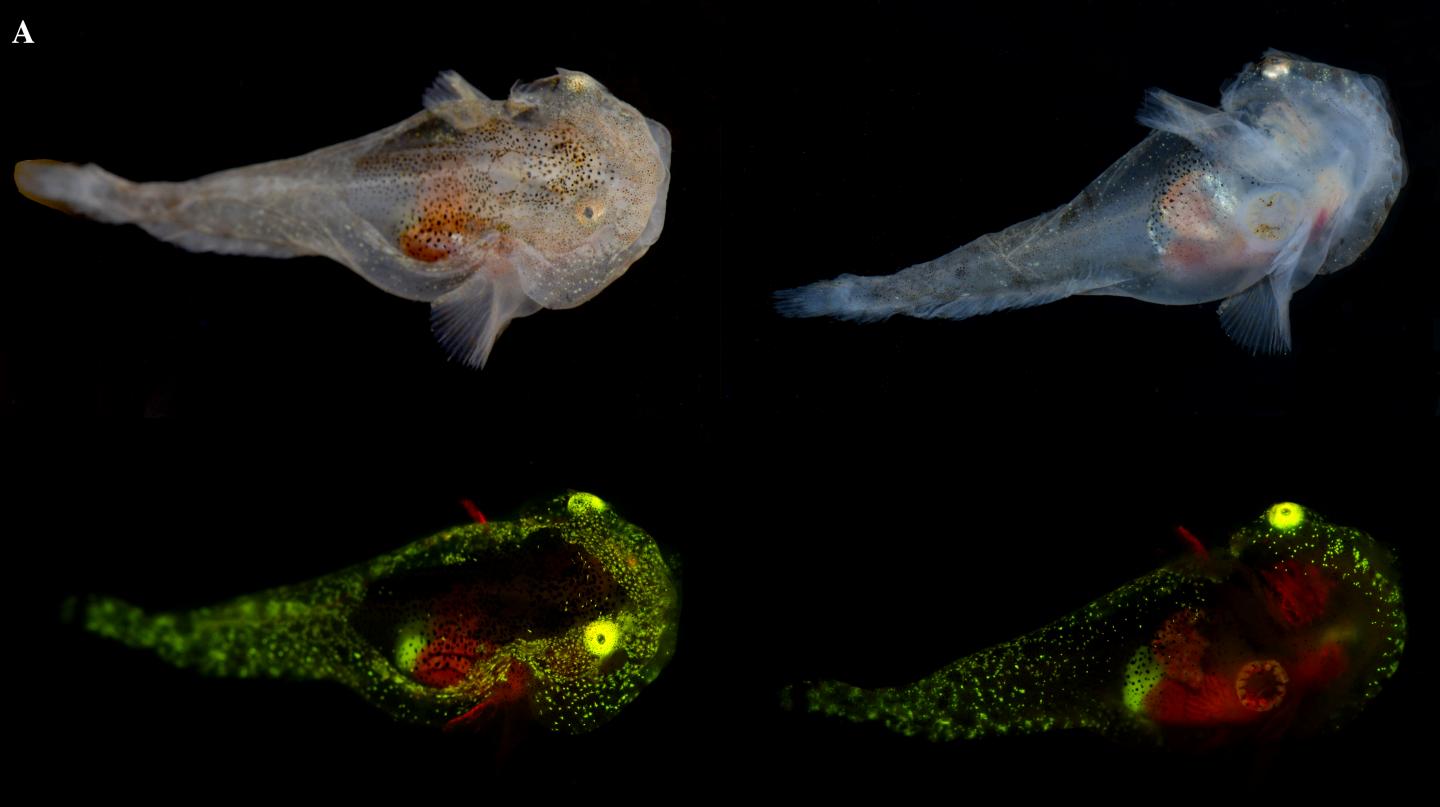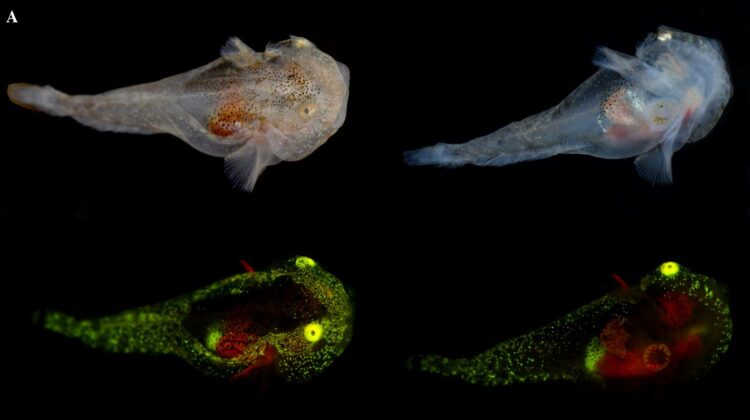Seasonal daylight makes biofluorescence rare in Arctic waters; snailfish living in iceberg habitats of Greeland buck trend with green and red glow

Credit: © J. Sparks, D. Gruber, P. Kragh
For the first time, scientists have documented biofluorescence in an Arctic fish species. The study, led by researchers at the American Museum of Natural History who spent hours in the icy waters off of Greenland where the red-and-green-glowing snailfish was found, is published today in the American Museum Novitates.
“Overall, we found marine fluorescence to be quite rare in the Arctic, in both invertebrate and vertebrate lineages,” said John Sparks, a curator in the American Museum of Natural History’s Department of Ichthyology and one of the authors of the study. “So we were surprised to find these juvenile snailfish brightly fluorescing in not just one, but two different colors, which is very unusual in a single species.”
In 2014, Sparks and colleague David Gruber, a research associate at the Museum and a biology professor at Baruch College, identified more than 180 new species of fishes that biofluoresce, the ability to convert blue wavelengths into green, red, or yellow light. This ability, which could be used for behaviors including communication and mating in some species, is now well documented in tropical fishes that live in regions where there is an even amount of daylight year-round. But in the Arctic, where days can be incredibly long or incredibly short, researchers were interested in seeing firsthand how prolonged periods of darkness affected fishes’ ability to biofluoresce.
“The light regime at the poles provides for winter months of near total darkness, where biofluorescence would not be functional,” Gruber said. “But given the summer months with the midnight Sun, we hypothesized that it could be present.”
In 2019, as part of a Constantine. S. Niarchos Expedition, Sparks and Gruber headed to the iceberg habitats off the coast of Eastern Greenland to test their theory. In addition to finding very little marine fluorescence, they observed that groups of fishes that glow brightly in tropical and temperate regions–for example, scorpionfishes and flatfishes–did not fluoresce in the cold waters. But there was an exception: two juvenile specimens of variegated snailfish (Liparis gibbus), the first species shown to biofluoresce in the Arctic. The species glows in both green and red, a rare example of multiple fluorescent colors emitted from a single organism. In addition, the authors report red biofluorescence from an adult kelp snailfish (L. tunicatus) collected in the Bering Strait off of Little Diomede Island, Alaska, which was collected and scanned by colleagues at NOAA Fisheries Service.
In the seven years since Sparks and Gruber first reported widespread biofluorescence in fishes, it has been found in a number of new lineages, including mammals like platypuses, opossums, flying squirrels, springhares, and even marine turtles. But its exact function remains a mystery.
“We are now focusing our efforts on determining the function of fluorescence in various fish groups, including catsharks, where we have shown that bright green fluorescence enhances contrast in their pigmentation pattern, making it easier for individuals to see each other at depth,” Sparks said.
###
This research was generously supported by the Stavros Niarchos Foundation through an AMNH Constantine S. Niarchos Expedition grant, and by the U.S. National Science Foundation grant no. DEB-1257555.
Study link: https:/
To watch a video piece about the researchers’ Greenland expedition, click here:
https:/
ABOUT THE AMERICAN MUSEUM OF NATURAL HISTORY (AMNH)
The American Museum of Natural History, founded in 1869 and currently celebrating its 150th anniversary, is one of the world’s preeminent scientific, educational, and cultural institutions. The Museum encompasses more than 40 permanent exhibition halls, including those in the Rose Center for Earth and Space, as well as galleries for temporary exhibitions. The Museum’s approximately 200 scientists draw on a world-class research collection of more than 34 million artifacts and specimens, some of which are billions of years old, and on one of the largest natural history libraries in the world. Through its Richard Gilder Graduate School, the Museum grants the Ph.D. degree in Comparative Biology and the Master of Arts in Teaching (MAT) degree, the only such free-standing, degree-granting programs at any museum in the United States. The Museum’s website, digital videos, and apps for mobile devices bring its collections, exhibitions, and educational programs to millions around the world. Visit amnh.org for more information.
Media Contact
Kendra Snyder
[email protected]





